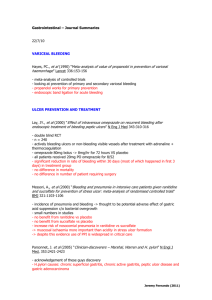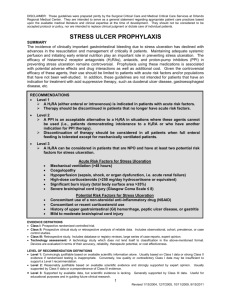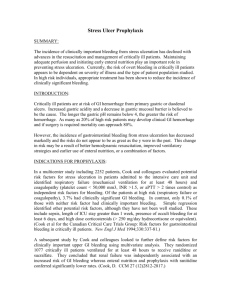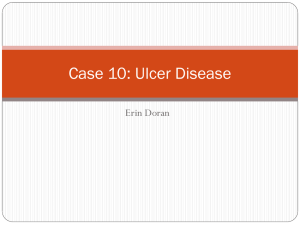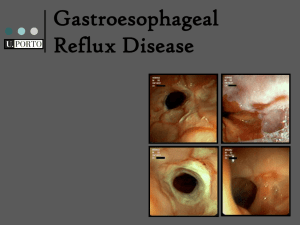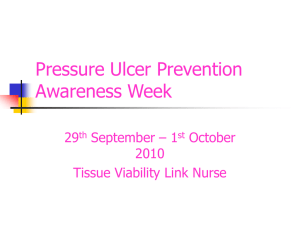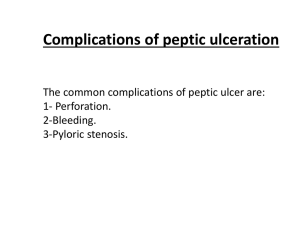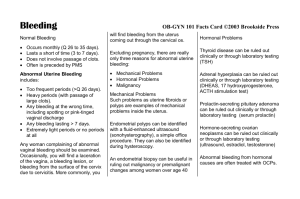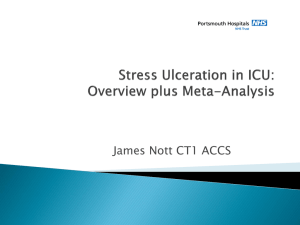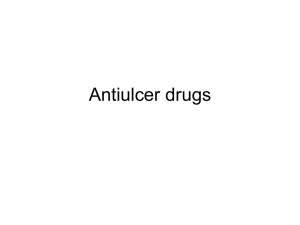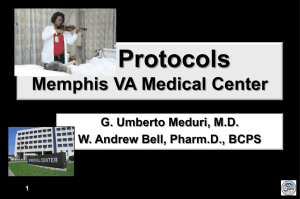Stress Ulcer Prophylaxis - Maricopa Medical Center
advertisement
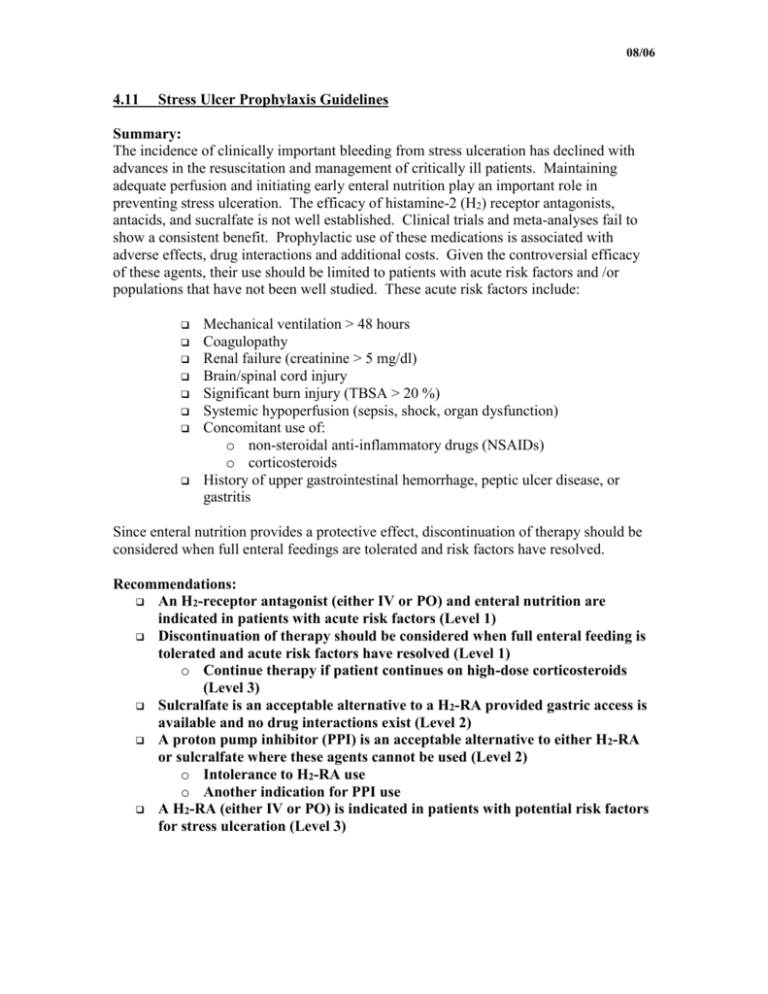
08/06 4.11 Stress Ulcer Prophylaxis Guidelines Summary: The incidence of clinically important bleeding from stress ulceration has declined with advances in the resuscitation and management of critically ill patients. Maintaining adequate perfusion and initiating early enteral nutrition play an important role in preventing stress ulceration. The efficacy of histamine-2 (H2) receptor antagonists, antacids, and sucralfate is not well established. Clinical trials and meta-analyses fail to show a consistent benefit. Prophylactic use of these medications is associated with adverse effects, drug interactions and additional costs. Given the controversial efficacy of these agents, their use should be limited to patients with acute risk factors and /or populations that have not been well studied. These acute risk factors include: Mechanical ventilation > 48 hours Coagulopathy Renal failure (creatinine > 5 mg/dl) Brain/spinal cord injury Significant burn injury (TBSA > 20 %) Systemic hypoperfusion (sepsis, shock, organ dysfunction) Concomitant use of: o non-steroidal anti-inflammatory drugs (NSAIDs) o corticosteroids History of upper gastrointestinal hemorrhage, peptic ulcer disease, or gastritis Since enteral nutrition provides a protective effect, discontinuation of therapy should be considered when full enteral feedings are tolerated and risk factors have resolved. Recommendations: An H2-receptor antagonist (either IV or PO) and enteral nutrition are indicated in patients with acute risk factors (Level 1) Discontinuation of therapy should be considered when full enteral feeding is tolerated and acute risk factors have resolved (Level 1) o Continue therapy if patient continues on high-dose corticosteroids (Level 3) Sulcralfate is an acceptable alternative to a H2-RA provided gastric access is available and no drug interactions exist (Level 2) A proton pump inhibitor (PPI) is an acceptable alternative to either H 2-RA or sulcralfate where these agents cannot be used (Level 2) o Intolerance to H2-RA use o Another indication for PPI use A H2-RA (either IV or PO) is indicated in patients with potential risk factors for stress ulceration (Level 3) 08/06 EVIDENCE DEFINITIONS • Class I: Prospective randomized controlled trial. • Class II: Prospective clinical study or retrospective analysis of reliable data. Includes observational, cohort, prevalence, or case control studies. • Class III: Retrospective study. Includes database or registry reviews, large series of case reports, expert opinion. • Technology assessment: A technology study which does not lend itself to classification in the above-mentioned format. Devices are evaluated in terms of their accuracy, reliability, therapeutic potential, or cost effectiveness. LEVEL OF RECOMMENDATION DEFINITIONS • Level 1: Convincingly justifiable based on available scientific information alone. Usually based on Class I data or strong Class II evidence if randomized testing is inappropriate. Conversely, low quality or contradictory Class I data may be insufficient to support a Level I recommendation. • Level 2: Reasonably justifiable based on available scientific evidence and strongly supported by expert opinion. Usually supported by Class II data or a preponderance of Class III evidence. • Level 3: Supported by available data, but scientific evidence is lacking. Generally supported by Class III data. Useful for educational purposes and in guiding future clinical research. Introduction Stress ulceration is a form of hemorrhagic gastritis occurring after a stressful event such as trauma and critical illness.1 Although not completely understood, the pathophysiology is thought to be multifactorial. Inadequate systemic circulation leading to mucosal blood flow reduction and tissue hypoxia are a likely etiology 1. Decreased gastric pH, increased mucosal permeability and alterations in normal protective mechanisms may also be contributing factors.1,2 Life threatening gastrointestinal bleeding has decreased since the early 1980’s due to improved resuscitation, early enteral feeding, and pharmacologic prophylaxis. Medications used for stress ulcer prophylaxis act by inhibiting gastric acid secretion; this neutralization of gastric acid production contributes to protecting the gastric mucosa. The efficacy of H2-receptor antagonists (H2-RA), antacids, and mucosal coating substances (i.e., sucralfate or carafate) has been extensively studied. Unfortunately, both placebo-controlled trials and meta-analyses have yielded conflicting results 1. Proton pump inhibitors (PPI) for stress ulcer prophylaxis have been evaluated as well. Although these agents generally keep gastric pH>4, this endpoint alone has yet to be proven to affect clinical outcome. Many investigators now question the value of these acid suppression and mucosal coating agents, especially in the setting of early enteral feeing. Prophylactic medications are associated with adverse effects, drug interactions, and additional costs. It is therefore important to limit their use to high risk populations. Several studies assessing risk factors for stress ulceration are discussed below. 1 American Society of Health-System Pharmacists. ASHP therapeutic guidelines on stress ulcer prophylaxis. Am J Health-Sys Pharm. 1999;56:347-79. 2 Cook D et al. for the Canadian Critical Care Trials Group: Risk factors for clinically important upper gastrointestinal bleeding in patients requiring mechanical ventilation. Crit Care Med 1999;27:2812-7. 08/06 Literature Review Risk factors for Stress Ulceration In a multicenter study including 2252 patients, Cook and colleagues identified respiratory failure (mechanical ventilation for at least 24 hours) and coagulopathy (platelet count < 50,000 mm3, INR >1.5, or aPTT > 2 times control) as independent risk factors for bleeding.3 Of the 33 (1.5%) patients with clinically important bleeding, 23 (70%) were receiving stress ulcer prophylaxis. However, the use of prophylaxis was not controlled and various regimens were administered. Further, enteral nutrition was not addressed. Only a small number of trauma patients were represented (28 head injuries, 18 multiple traumas). (Class II) A subsequent study by Cook and colleagues identified maximum serum creatinine as a risk factor (RR=1.16) for clinically important upper gastrointestinal bleeding in a multivariate analysis.2 All patients received either ranitidine or sucralfate. The use of enteral feeding was not randomized. Enteral nutrition (RR=0.3) and ranitidine (RR=0.39) were protective. The overall incidence of clinically important gastrointestinal bleeding was 2.8%. None of the 147 trauma patients had clinically important bleeding. (Class I) Other risk factors have been identified, although they have not been well studied. These include sepsis, length of ICU stay greater than 1 week, presence of occult bleeding for at least 6 days, and high dose corticosteroids (> 250 mg/day hydrocortisone or equivalent).1 There is evidence that the incidence of stress ulceration is higher when more than one risk factor is present.4 Patients suffering burn or neurologic injury were frequently excluded from studies due to their presumably high risk for the development of stress ulcers. Additional populations frequently excluded from clinical trials include patients with a history of upper gastrointestinal hemorrhage, peptic ulcer disease, or NSAID use. Whether these conditions translate into an increased risk of acute, stress-induced bleeding is unknown.3 3 Cook et al. for the Canadian Critical Care Trials Group: Risk factors for gastrointestinal bleeding in critically ill patients. New Engl J Med 1994;330:337-81. 4 Metz et al. for the Ranitidine Head Injury Study Group: Impact of multiple risk factors and ranitidine prophylaxis on the development of stress-related upper gastrointestinal bleeding: a prospective, multicenter, double-blind randomized trial. Crit Care Med 1993;21:1844-9. 08/06 Proton Pump Inhibitors (PPIs) Phillips et al. 5 performed a prospective, open-label trial evaluating the efficacy of omeprazole suspension for stress ulcer prophylaxis in 75 critically ill patients. Patients were considered for the study if they were admitted to the surgical or burn ICU with an intact stomach, a nasogastric tube, and an anticipated ICU length of stay > 48 hours. They also had to have a gastric pH < 4, be on mechanical ventilation, and have an additional risk factor for stress ulceration. Patients were excluded if they were receiving enteral feedings through the nasogastric tube. Omeprazole suspension was administered as 40 mg, followed by a second 40 mg dose 6 to 8 hours later, then 20 mg daily until there was no longer a need for stress ulcer prophylaxis. Ten patients received H2-RAs prior to omeprazole suspension. Of the 65 patients who received omeprazole suspension as their initial prophylaxis, none developed overt or clinically significant upper gastrointestinal bleeding. Omeprazole significantly increased the mean gastric pH within 4 hours of the start of therapy (3.5 to 7.1). (Class II) In a similar study, the efficacy of omeprazole suspension was evaluated in 66 patients with severe trauma 6. In addition to mechanical ventilation, patients were required to have at least one other risk factor for stress ulceration. Patients were excluded if they were receiving gastric feedings. Omeprazole was administered as described in the previous study. None of the patients developed overt or clinically significant upper gastrointestinal bleeding. Gastric pH monitoring revealed a statistically significant increase following initiation of omeprazole therapy (3 patients required an increased dose to achieve adequate pH control). (Class II) Levy et al. compared the efficacy of omeprazole versus ranitidine for prophylaxis against clinically important gastrointestinal hemorrhage in 67 patients admitted to an ICU who had at least one risk factor for stress ulceration 7. Patients were randomized to receive ranitidine (50 mg bolus followed by 150 mg daily by continuous infusion or intermittent administration) or omeprazole (40 mg daily orally or via nasogastric tube). Clinically important bleeding occurred in significantly more ranitidine patients compared to omeprazole patients (31% versus 6%; p=0.013). It should be noted that the ranitidine patients had significantly more risk factors for stress ulceration than the omeprazole patients did. The use of enteral nutrition was not addressed. (Class I) 5 Phillips JO et al. A prospective study of simplified omeprazole suspension for the prophylaxis of stressrelated mucosal damage. Crit Care Med 1996; 24: 1793-1800. 6 Lasky MR et al. A prospective study of omeprazole suspension to prevent clinically significant gastrointestinal bleeding from stress ulcers in mechanically ventilated trauma patients. J Trauma 1998; 44: 527-33. 7 Levy MJ et al. Comparison of omeprazole and ranitidine for stress ulcer prophylaxis. Dig Dis Sci 1997; 42: 1255-9. 08/06 A number of additional trials 8, 9, 10 have been performed comparing the effects of H2-RAs and PPIs on gastric pH and / or prevention of upper gastrointestinal hemorrhage; however, the results are only published in abstract form at this time. Allen and colleagues published a thorough review of stress ulcer prophylaxis in the post-operative period in which the most recent studies addressing this topic are discussed 11. 8 Phillips JO et al. A multicenter, prospective, randomized clinical trial of continuous infusion I.V. ranitidine vs. omeprazole suspension in the prophylaxis of stress ulcers. Crit Care Med 1998; 26: 101A. 9 Azevedo JR et al. Prevention of stress ulcer bleeding in high risk patients. Comparison of three drugs. Crit Care Med 1999; 27: A145. 10 Roberts KW et al. Effect of lansoprazole suspension versus continuous intravenous ranitidine infusion on gastric pH of mechanically ventilated intensive care unit patients. Pharmacother 2000; 20: 342. 11 Allen ME et al. Stress ulcer prophylaxis in the postoperative period. Am J Health-Syst Pharm 2004; 61: 588-96.
